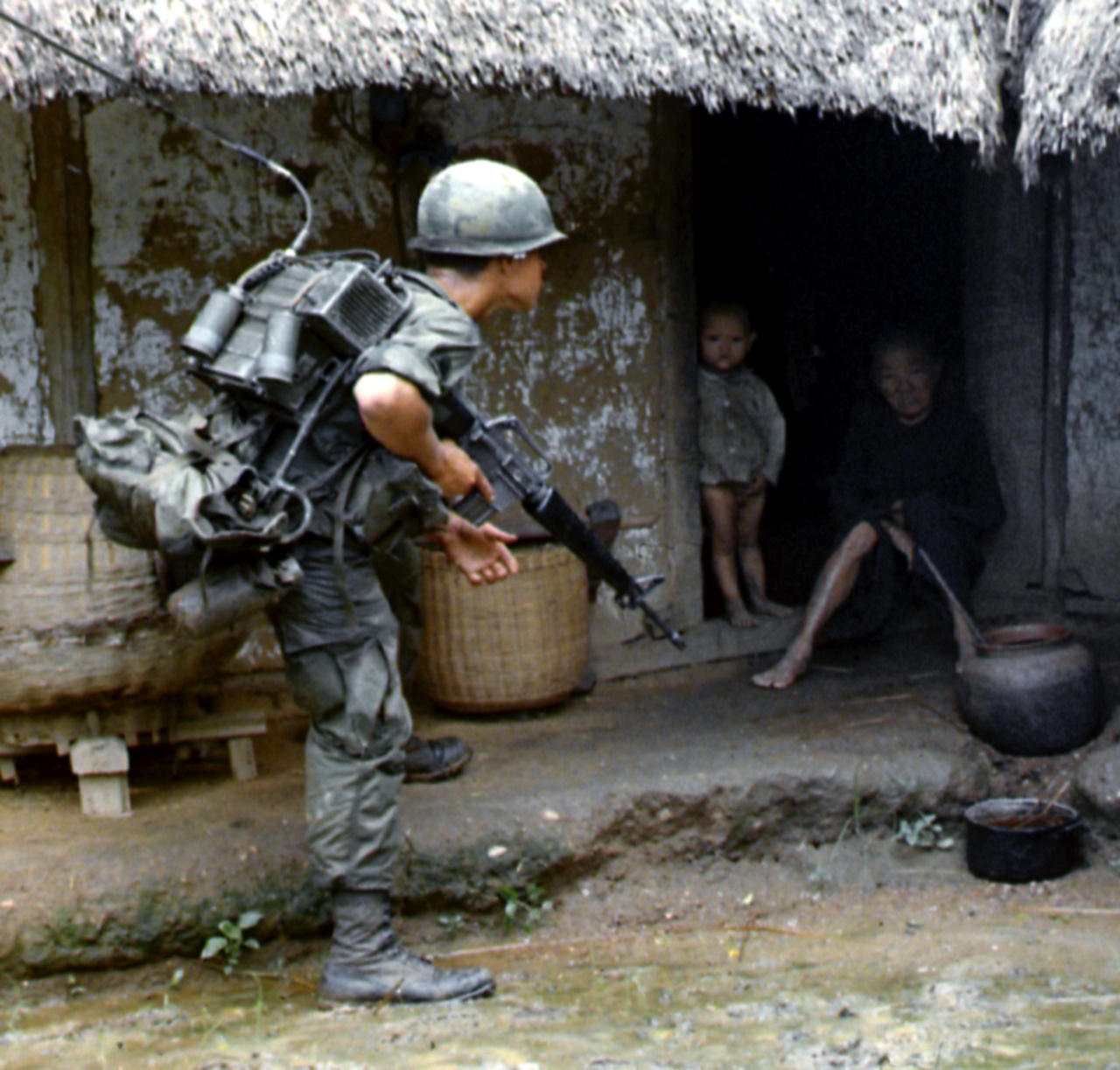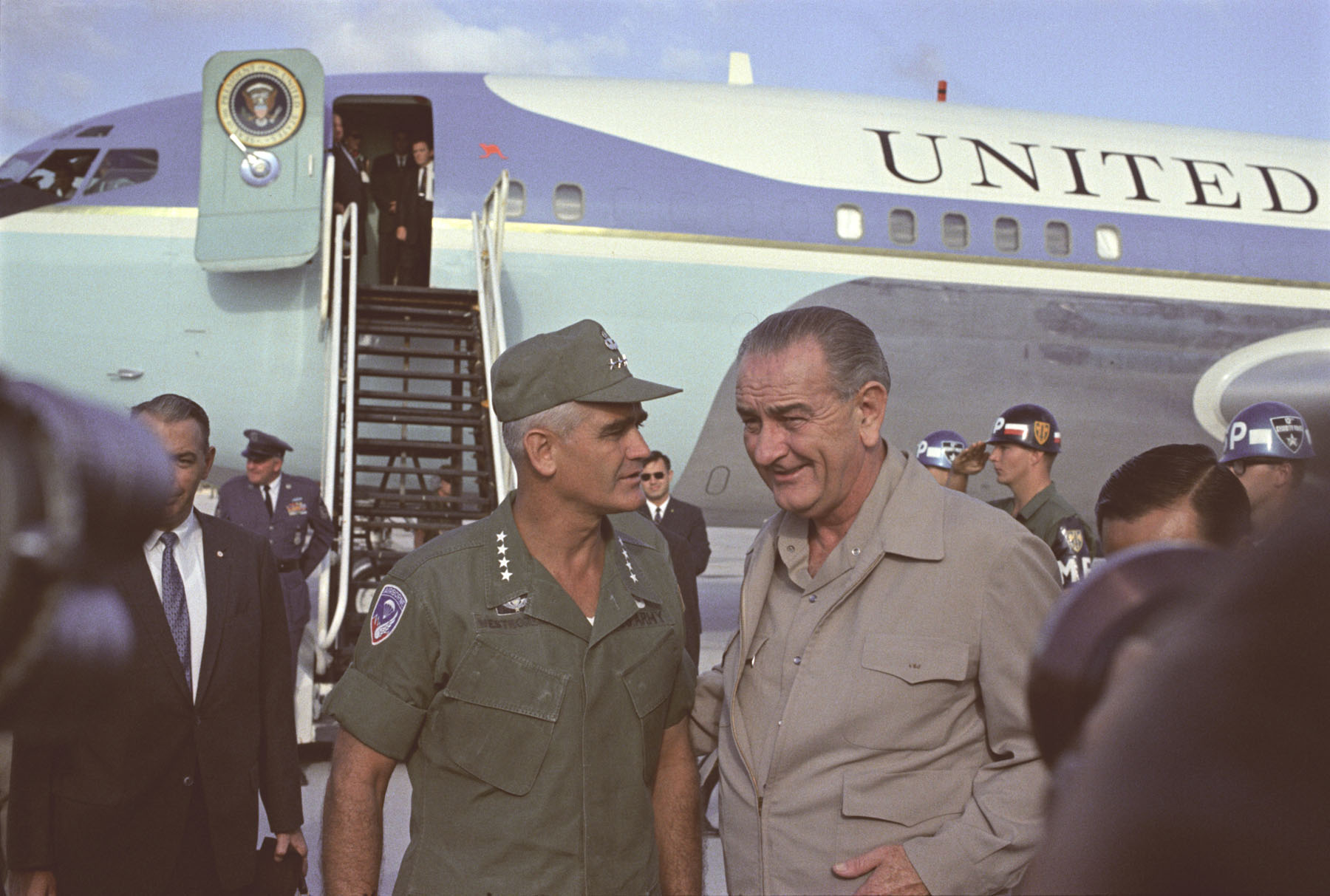|
Operation Attleboro
Operation Attleboro was a Vietnam War search and destroy operation initiated by the 196th Light Infantry Brigade with the objective to discover the location(s) of People's Army of Vietnam (PAVN) and Viet Cong (VC) base areas and force them to fight. The operation was named after Attleboro, Massachusetts, where the brigade had been formed. Operation Attleboro grew to be the largest series of air mobile operations to that time, involving all or elements of the 196th Brigade, 25th Infantry Division, 1st Infantry Division and a brigade of the 4th Infantry Division, as well as numerous Army of the Republic of Vietnam and Regional Forces/Popular Forces and Nùngs. In the end, the operation became a Corps operation commanded by II Field Force, Vietnam. Background In late 1966 interdiction remained a high priority for US forces, and, until the dry season began in earnest, COMUSMACV General William Westmoreland's primary concern remained blocking the three infiltration corridor ... [...More Info...] [...Related Items...] OR: [Wikipedia] [Google] [Baidu] |
Vietnam War
The Vietnam War (also known by #Names, other names) was a conflict in Vietnam, Laos, and Cambodia from 1 November 1955 to the fall of Saigon on 30 April 1975. It was the second of the Indochina Wars and was officially fought between North Vietnam and South Vietnam. The north was supported by the Soviet Union, China, and other communist states, while the south was United States in the Vietnam War, supported by the United States and other anti-communism, anti-communist Free World Military Forces, allies. The war is widely considered to be a Cold War-era proxy war. It lasted almost 20 years, with direct U.S. involvement ending in 1973. The conflict also spilled over into neighboring states, exacerbating the Laotian Civil War and the Cambodian Civil War, which ended with all three countries becoming communist states by 1975. After the French 1954 Geneva Conference, military withdrawal from Indochina in 1954 – following their defeat in the First Indochina War – the Viet Minh to ... [...More Info...] [...Related Items...] OR: [Wikipedia] [Google] [Baidu] |
Search And Destroy
Search and destroy, seek and destroy, or simply S&D is a military strategy best known for its employment in the Malayan Emergency and the Vietnam War. The strategy consists of inserting ground forces into hostile territory, ''search''ing out the enemy, ''destroy''ing them, and withdrawing immediately afterward. The strategy was developed to take advantage of the capabilities offered by a new technology, the helicopter, which resulted in a new form of warfare, the fielding of air cavalry, and was thought to be ideally suited to counter-guerrilla jungle warfare. The complementary conventional strategy, which entailed attacking and conquering an enemy position, then fortifying and holding it indefinitely, was known as " clear and hold" or "clear and secure". In theory, since the traditional methods of "taking ground" could not be used in this war (as all disputed territory was technically already under the control of allied forces), a war of attrition would be used, with the ... [...More Info...] [...Related Items...] OR: [Wikipedia] [Google] [Baidu] |
Nguyễn Chí Thanh
Nguyễn Chí Thanh (1 January 1914 – 7 July 1967) was a General in the North Vietnamese Vietnam People's Army and former North Vietnamese politician. Nguyễn Chí Thanh was born in Thừa Thiên Province in Central Vietnam to a peasant family. His original name was Nguyễn Văn Vịnh. He joined the Indochinese Communist Party in the mid-1930s and apparently spent most of the Second World War in a French prison. He worked for the Party in Central Vietnam until his rise to the Politburo in 1951. During the First Indochina War Thanh was made a general of the People's Army of Vietnam. From 1965 until his death he served as the leading strategist and military commander of COSVN, the southern headquarters of communist military and political operations within the Republic of Vietnam. In 1967, he presented plans for what was to become the Tet Offensive to the Politburo, but died shortly after receiving permission to implement his plan. Revolutionary cause Nguyễn Chí Thanh w ... [...More Info...] [...Related Items...] OR: [Wikipedia] [Google] [Baidu] |
William Westmoreland
William Childs Westmoreland (March 26, 1914 – July 18, 2005) was a United States Army general, most notably commander of United States forces during the Vietnam War The Vietnam War (also known by #Names, other names) was a conflict in Vietnam, Laos, and Cambodia from 1 November 1955 to the fall of Saigon on 30 April 1975. It was the second of the Indochina Wars and was officially fought between North Vie ... from 1964 to 1968. He served as Chief of Staff of the United States Army from 1968 to 1972. Westmoreland adopted a strategy of Attrition warfare, attrition against the Viet Cong and the North Vietnamese Army, attempting to drain them of manpower and supplies. He also made use of the United States' edge in artillery and air power, both in tactical confrontations and in relentless strategic bombing of North Vietnam. Nevertheless, public support for the war eventually diminished, especially after the Battle of Khe Sanh and the Tet Offensive in 1968. By the time he was r ... [...More Info...] [...Related Items...] OR: [Wikipedia] [Google] [Baidu] |
General (united States)
In the United States military, a general is the most senior general-grade officer; it is the highest achievable commissioned officer rank (or echelon) that may be attained in the United States Armed Forces, with exception of the Navy and Coast Guard, which have the equivalent rank of admiral instead. The official and formal insignia of "general" is defined by its four stars (commonly silver and in a row). The rank of general ranks above a three-star lieutenant general and below the special wartime five-star ranks of General of the Army or General of the Air Force. The Marine Corps and Space Force do not have an established grade above general. The pay grade of general is O-10. It is equivalent to the rank of admiral in the other United States uniformed services which use naval ranks. It is abbreviated as GEN in the Army and Gen in the Marine Corps, Air Force, and Space Force. Since the ranks of General of the Army and General of the Air Force are reserved for wartime us ... [...More Info...] [...Related Items...] OR: [Wikipedia] [Google] [Baidu] |
COMUSMACV
U.S. Military Assistance Command, Vietnam (MACV) was a joint-service command of the United States Department of Defense. MACV was created on 8 February 1962, in response to the increase in United States military assistance to South Vietnam. MACV was first implemented to assist the Military Assistance Advisory Group (MAAG) Vietnam, controlling every advisory and assistance effort in Vietnam, but was reorganized on 15 May 1964 and absorbed MAAG Vietnam to its command when combat unit deployment became too large for advisory group control. MACV was disestablished on 29 March 1973 and replaced by the Defense Attaché Office (DAO), Saigon. The DAO performed many of the same roles of MACV within the restrictions imposed by the Paris Peace Accords until the Fall of Saigon. The first commanding general of MACV (COMUSMACV), General Paul D. Harkins, was also the commander of MAAG Vietnam, and after reorganization was succeeded by General William C. Westmoreland in June 1964, followed by ... [...More Info...] [...Related Items...] OR: [Wikipedia] [Google] [Baidu] |
II Field Force, Vietnam
II Field Force, Vietnam was a United States Army Corps-level command during the Vietnam War. Activated on 15 March 1966, it became the largest corps command in Vietnam and one of the largest in Army history. II Field Force was assigned the lineage of the XXII Corps, a World War II corps in the European Theater of Operations. II Field Force was a component of U.S. Military Assistance Command Vietnam (MACV) and had its headquarters in Long Binh. Area of responsibility II Field Force's area of responsibility was III Corps Tactical Zone, later renamed Military Region 3, which comprised eleven provinces surrounding Saigon. This was designed to mimic the ARVN III Corps region. II Field Force controlled units participating in the 1968 Tet Offensive and the 1970 Cambodian Incursion. Units assigned At various times during the Vietnam War, II FFV controlled the following units: *1st Infantry Division * 9th Infantry Division * 25th Infantry Division *101st Airborne Division * 1st Cav ... [...More Info...] [...Related Items...] OR: [Wikipedia] [Google] [Baidu] |
Nùng People
The Nùng (''pronounced as noong'' uːŋ are a Central Tai-speaking ethnic group living primarily in northeastern Vietnam and southwestern Guangxi. The Nùng sometimes call themselves Tho, which literally means '' autochthonous'' (indigenous or native to the land). Their ethnonym is often mingled with that of the Tày as Tày-Nùng. According to the Vietnam census, the population of the Nùng numbered about 856,412 by 1999, 968,800 by 2009, and 1,083,298 by 2019. They are the third largest Tai-speaking group, preceded by the Tày and the Thái ( Black Tai, White Tai and Red Tai groups), and sixth overall among national minority groups. They are closely related to the Tày and the Zhuang. In China, the Nùng together with the Tày are classified as Zhuang people. Subdivisions There are several subgroups among the Nùng: Nùng Xuồng, Nùng Giang, Nùng An, Nùng Phàn Slình, Nùng Lòi, Nùng Cháo, Nùng Quý Rỉn, Nùng Dín, Nùng Inh, Nùng Tùng Slìn etc. Man ... [...More Info...] [...Related Items...] OR: [Wikipedia] [Google] [Baidu] |
South Vietnamese Regional Force
The South Vietnamese Regional Forces ( vi, Địa phương quân, lit. "Local Army"), originally the Civil Guard, were a component of Army of the Republic of Vietnam (ARVN) territorial defence forces. Recruited locally, they served as full-time province-level forces, originally raised as a militia. In 1964, the Regional Forces were integrated into the ARVN and placed under the command of the Joint General Staff. The concept of Regional Forces was to counter the Viet Cong (VC) Local Force units, while the ARVN regular forces fought the better equipped VC Main Force units and the People's Army of Vietnam (PAVN). Local militia came to play a very effective role in the war, as the style of small-unit warfare was better suited for guerrilla conflicts with most more familiar with the region and terrain. Despite being poorly paid, these forces were much more capable at detecting infiltration and holding civilian areas. Accounting for an estimated 2-5% of war budget, the Regional Force ... [...More Info...] [...Related Items...] OR: [Wikipedia] [Google] [Baidu] |
Army Of The Republic Of Vietnam
The Army of the Republic of Vietnam (ARVN; ; french: Armée de la république du Viêt Nam) composed the ground forces of the South Vietnamese military from its inception in 1955 to the Fall of Saigon in April 1975. It is estimated to have suffered 1,394,000 casualties (killed and wounded) during the Vietnam War. The ARVN began as a postcolonial army that was trained by and closely affiliated with the United States and had engaged in conflict since its inception. Several changes occurred throughout its lifetime, initially from a 'blocking-force' to a more modern conventional force using helicopter deployment in combat. During the American intervention, the ARVN was reduced to playing a defensive role with an incomplete modernisation, and transformed again following Vietnamization, it was upgeared, expanded, and reconstructed to fulfill the role of the departing American forces. By 1974, it had become much more effective with foremost counterinsurgency expert and Nixon adviser ... [...More Info...] [...Related Items...] OR: [Wikipedia] [Google] [Baidu] |








